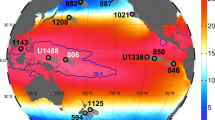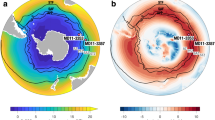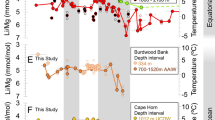Abstract
Many records of tropical sea surface temperature and marine productivity exhibit cycles of 23 kyr (orbital precession) and 100 kyr during the past 0.5 Myr (refs 1–5), whereas high-latitude sea surface temperature records display much more pronounced obliquity cycles at a period of about 41 kyr (ref. 6). Little is known, however, about tropical climate variability before the mid-Pleistocene transition about 900 kyr ago, which marks the change from a climate dominated by 41-kyr cycles7 (when ice-age cycles and high-latitude sea surface temperature variations were dictated by changes in the Earth's obliquity8,9) to the more recent 100-kyr cycles of ice ages. Here we analyse alkenones from marine sediments in the eastern equatorial Pacific Ocean to reconstruct sea surface temperatures and marine productivity over the past 1.8 Myr. We find that both records are dominated by the 41-kyr obliquity cycles between 1.8 and 1.2 Myr ago, with a relatively small contribution from orbital precession, and that early Pleistocene sea surface temperatures varied in the opposite sense to local annual insolation in the eastern equatorial Pacific Ocean. We conclude that during the early Pleistocene epoch, climate variability at our study site must have been determined by high-latitude processes that were driven by orbital obliquity forcing.
This is a preview of subscription content, access via your institution
Access options
Subscribe to this journal
Receive 51 print issues and online access
$199.00 per year
only $3.90 per issue
Buy this article
- Purchase on Springer Link
- Instant access to full article PDF
Prices may be subject to local taxes which are calculated during checkout



Similar content being viewed by others
References
Molfino, B. & McIntyre, A. Precessional forcing of nutricline dynamics in the Equatorial Atlantic. Science 249, 766–769 (1990)
Schneider, R. R., et al. in The South Atlantic: Present and Past Circulation (eds Wefer, G., Berger, W. H., Siedler, G. & Webb, D. J.) 527–551 (Springer, Berlin, 1996)
Rostek, F., Bard, E., Beaufort, L., Sonzogni, C. & Ganssen, G. Sea surface temperature and productivity records for the past 240 kyr in the Arabian Sea. Deep Sea Res. II 44, 1461–1480 (1997)
Budziak, D. S. et al. Late Quaternary insolation forcing on total organic carbon and C37 alkenone variations in the Arabian Sea. Paleoceanography 15, 307–321 (2000)
Perks, H., Charles, C. D. & Keeling, R. F. Precessionally forced productivity variations across the equatorial Pacific. Paleoceanography 17, 63–69 (2002)
Ruddiman, W. F. & McIntyre, A. Ice-age thermal response and climatic role of the surface North Atlantic ocean, 40 to 63 N. Bull. Geol. Soc. Am. 95, 381–396 (1984)
Raymo, M. E. & Nisancioglu, K. The 41 kyr world: Milankovitch's other unsolved mystery. Paleoceanography 18, 10.1029/2002PA000791 (2003)
Shackleton, N. J., Berger, A. & Peltier, W. R. An alternative astronomical calibration of the lower Pleistocene timescale based on ODP site 677. Trans. R. Soc. Edinb. Earth Sci. 81, 251–261 (1990)
Ruddiman, W. F., Raymo, M. E., Martinson, D. G., Clement, B. M. & Backman, J. Pleistocene evolution: northern hemisphere ice sheets and North Atlantic Ocean. Paleoceanography 4, 353–412 (1989)
Milankovitch, M. K. Kanon der erdbestrahlung und seine anwendung anf daseiszeitenproblem. Serb. Acad. Beorg. Spec. Publ. 132 (1941)
Hays, J. D., Imbrie, J. & Shackleton, N. J. Variations in the Earth's orbit: Pacemaker of the ice ages. Science 194, 1121–1132 (1976)
Imbrie, J. et al. On the structure and origin of major glaciation cycles 2: The 100,000 year cycle. Paleoceanography 8, 699–735 (1993)
Berger, A. L. Long-term variations of daily insolation and quaternary climatic change. J. Atmos. Sci. 35, 2362–2367 (1978)
Clemens, S., Prell, W., Murray, D., Shimmield, G. & Weedon, G. Forcing mechanisms of the Indian ocean monsoon. Nature 353, 720–725 (1991)
Beaufort, L., de Garidel-Thoron, T., Mix, A. C. & Pisias, N. G. ENSO-like forcing on oceanic primary production during the late Pleistocene. Science 293, 2440–2444 (2001)
Lea, D. W., Pak, D. K. & Spero, H. J. Climate impact of late Quaternary equatorial Pacific sea surface temperature variations. Science 289, 1719–1724 (2000)
Bloemendal, J. & deMenocal, P. Evidence for a change in the periodicity of tropical climate cycles at 2.4 Myr from whole-core magnetic susceptibility measurements. Nature 342, 897–900 (1989)
Levitus, S. & Boyer, T. P. World Ocean Atlas 1994 Vol. 4, Temperature (NOAA Atlas NESDIS Vol. 4, US Department of Commerce, Washington DC, 1994)
Mix, A. C., Le, J. & Shackleton, N. J. Benthic foraminerferal stable isotope stratigraphy of Site 846: 0-1.8 Ma. Sci. Res. ODP 138, 839–856 (1995)
Emeis, K.-C., Doose, H., Mix, A. & Schulz-Bull, D. Alkenone sea-surface temperatures and carbon burial at Site 846 (eastern equatorial Pacific Ocean): the last 1.3 m.y. Sci. Res. ODP 138, 605–614 (1995)
Lyle, M. W., Prahl, F. G. & Sparrow, M. A. Upwelling and productivity changes inferred from a temperature record in the central equatorial Pacific. Nature 355, 812–815 (1992)
Bush, A. B. G. & Philander, S. G. H. The role of ocean-atmosphere interactions in tropical cooling during the last glacial maximum. Science 279, 1341–1344 (1998)
Philander, S. G. H. & Fedorov, A. V. Role of tropics in changing the response to Milankovitch forcing some three million years ago. Paleoceanography 18, 10.1029/2002PA000837 (2003)
Prahl, F. G., Muehlhausen, L. A. & Zahnle, D. L. Further evaluation of long-chain alkenones as indicators of paleoceanographic conditions. Geochim. Cosmochim. Acta 52, 2303–2310 (1988)
Herbert, T. D. et al. Depth and seasonality of alkenone production along the California margin inferred from a core-top transect. Paleoceanography 13, 263–271 (1998)
Muller, P. J., Krist, G., Ruhland, G., Von Storch, I. & Rossell-Mele, A. Calibration of the alkenone paleotemperature index Uk′37 based on core-tops from the eastern South Atlantic and the global ocean (60N–60S). Geochim. Cosmochim. Acta 62, 1757–1772 (1998)
Paillard, D., Labeyrie, L. & Yiou, P. Macintosh program performs time-series analysis. Eos 77, 379 (1996)
Acknowledgements
We thank the curators of the Ocean Drilling Program (Texas A&M University) for providing samples. The original draft was improved by comments from S. Clemens, K. Lawrence and L. Lisiecki. This work was supported by the NSF (T.D.H.).
Author information
Authors and Affiliations
Corresponding author
Ethics declarations
Competing interests
The authors declare that they have no competing financial interests.
Supplementary information
Supplementary Figure 1
Location of ODP Site 846 in the eastern Pacific Ocean. (PDF 211 kb)
Supplementary Figure 2
Normalized Pleistocene SST and (log-transformed) alkenone abundance records, with filtered obliquity and precession signals. (PDF 542 kb)
Supplementary Figure 3
Coherencies and phase relationships in the late Pleistocene (0-0.6 Ma). (PDF 272 kb)
Rights and permissions
About this article
Cite this article
Liu, Z., Herbert, T. High-latitude influence on the eastern equatorial Pacific climate in the early Pleistocene epoch. Nature 427, 720–723 (2004). https://doi.org/10.1038/nature02338
Received:
Accepted:
Issue Date:
DOI: https://doi.org/10.1038/nature02338
This article is cited by
-
The influence of subpolar marine ice expansion on global climate in the Early Pleistocene
npj Climate and Atmospheric Science (2024)
-
Loess deposits in the low latitudes of East Asia reveal the ~20-kyr precipitation cycle
Nature Communications (2024)
-
Late Miocene cooling coupled to carbon dioxide with Pleistocene-like climate sensitivity
Nature Geoscience (2022)
-
Tropical forcing orbital-scale precipitation variations revealed by a maar lake record in South China
Climate Dynamics (2022)
-
Pliocene decoupling of equatorial Pacific temperature and pH gradients
Nature (2021)
Comments
By submitting a comment you agree to abide by our Terms and Community Guidelines. If you find something abusive or that does not comply with our terms or guidelines please flag it as inappropriate.



